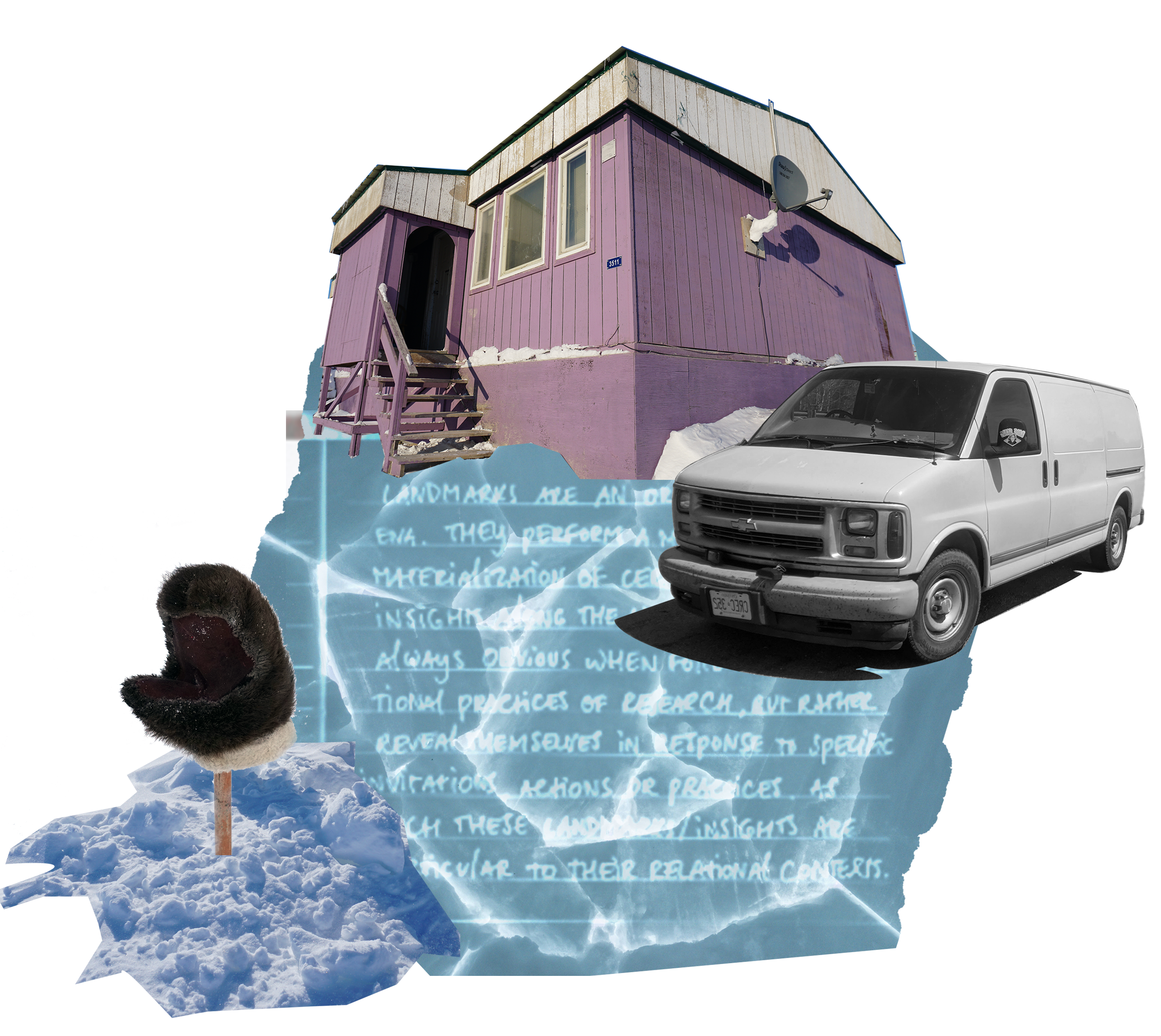Entering Into Relationship: Difference between revisions
Created page with "thumb 'Is “polite” refusal ultimately a colonizing action?' (Martin, 2016) With this question Keavy Martin ties up questions of responsibility with the matter of Inuit and non-Inuit encountering each other. She explores what acknowledging or honouring relationships as a decolonial practice might look like, through the ethics of hunting and eating of animals (ibid). She links the matters of such bodily sharing, with sustenance and survival - wi..." |
No edit summary |
||
| Line 1: | Line 1: | ||
[[File:Landmark.png|thumb]] | [[File:Landmark.png|thumb]] | ||
To "enter into into relationship" in an Inuit context, means to partake in the reciprocal customs of gifting and sharing, and allowing yourself to be transformed by those processes (Martin, 2016). | |||
The filming of Kathy and Janet throatsinging, of Percy and Aldina drumdancing on the tundra, and Holle, Angeline and Mary singing the Pihhiq, was more part of such "entering into relationship", that it was about collecting data about traditional songs and dance, and the knowledge that is embedded within them. Although the potentials for knowledge renewal between generations were obvious once engaged in the practices and processes of filmmaking, this seemed to have less to do with the film making, or even the particular activity that we were filming, than with the fact that these activities allowed us to come together and create something. | |||
Although | Although, I was provided months later after I returned to share initial edits, with a line-by-line rough interpretation of the Pihhiq, it already was clear to me that as a non-Inuit researcher I would not be able to fully grasp the extent of cultural significance that these aesthetic actions embody. What I could do, however, as a community-based researcher with a professional background in film was engage with these practices by way of film-making. As each person brought their own knowledge, skills, and practices to the process of doing so, the shooting of these video provided for a space to encounter each other on our own terms. | ||
<div class="next_choice">Return to cut 2</div> | |||
<span class="return to cut 2 link" data-page-title="Point of Beginning Animated Graphic Documentary" data-section-id="3" data-encounter-type="return">[[Point of Beginning Animated Graphic Documentary#Audio Recording and Translation|Return to Cut 2: "Co-creating the Animated Graphic Documentary"]]</span> | <span class="return to cut 2 link" data-page-title="Point of Beginning Animated Graphic Documentary" data-section-id="3" data-encounter-type="return">[[Point of Beginning Animated Graphic Documentary#Audio Recording and Translation|Return to Cut 2: "Co-creating the Animated Graphic Documentary"]]</span> | ||
Revision as of 17:14, 17 January 2025

To "enter into into relationship" in an Inuit context, means to partake in the reciprocal customs of gifting and sharing, and allowing yourself to be transformed by those processes (Martin, 2016).
The filming of Kathy and Janet throatsinging, of Percy and Aldina drumdancing on the tundra, and Holle, Angeline and Mary singing the Pihhiq, was more part of such "entering into relationship", that it was about collecting data about traditional songs and dance, and the knowledge that is embedded within them. Although the potentials for knowledge renewal between generations were obvious once engaged in the practices and processes of filmmaking, this seemed to have less to do with the film making, or even the particular activity that we were filming, than with the fact that these activities allowed us to come together and create something.
Although, I was provided months later after I returned to share initial edits, with a line-by-line rough interpretation of the Pihhiq, it already was clear to me that as a non-Inuit researcher I would not be able to fully grasp the extent of cultural significance that these aesthetic actions embody. What I could do, however, as a community-based researcher with a professional background in film was engage with these practices by way of film-making. As each person brought their own knowledge, skills, and practices to the process of doing so, the shooting of these video provided for a space to encounter each other on our own terms.
Return to Cut 2: "Co-creating the Animated Graphic Documentary"
